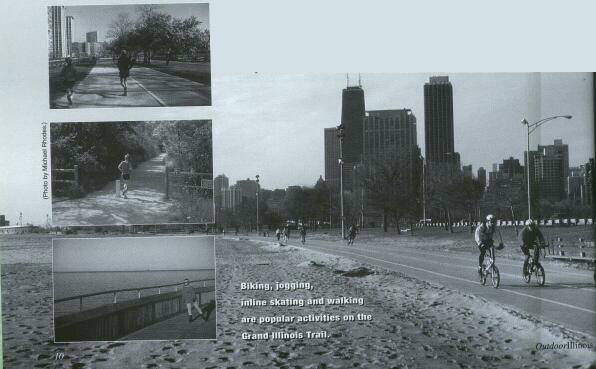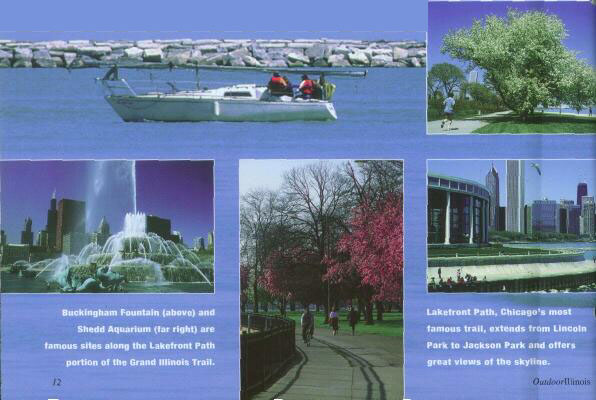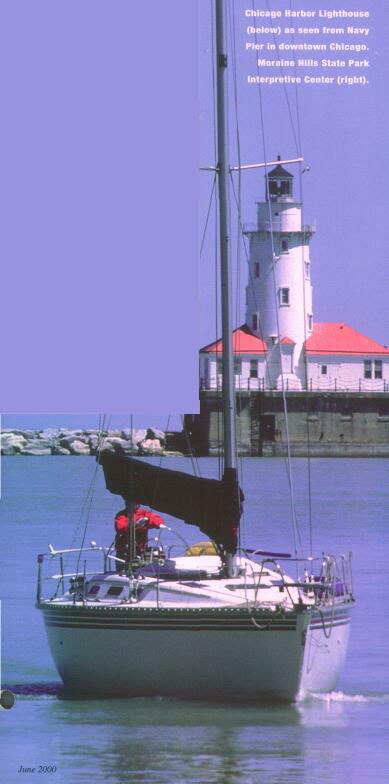|
A Work in Progress
BY Liz PENSONEAU
PHOTOS BY ADELE HODDE
Consider this scenario. It's
June and your vacation time
looms on the horizon. You'd
like a change of pace from the
usual road trip. You'd like to see
some sights from a new perspective, get some exercise and maybe
|
When it comes to seeing Illinois, we're all
familiar with traveling by rail, by air
and by highway. Now there's another
option-the Grand Illinois Trail.
even connect with nature. If you
can identify with this, consider a
trip across the Grand Illinois Trail.
|
This month marks the official
celebration of the trail and its nearly 500 miles of scenic vistas. Myriad partnerships have allowed
Department of Natural Resources
trails to couple with local existing
trails, making it possible to travel
from northeastern Illinois to northwestern Illinois via a network of
trails that offer expansive opportunities for hiking, hiking and other
recreational activities.
Dick Westfall, head of the
Greenways and Trails Section in
DNR's Division of Planning, said
much of the GIT is completed and
open to use. However, other sections-especially in the north central .11
and western regions-are either in
the planning or construction stage,
with interim routes currently paralleling some of the construction
zones. Regardless of the status of
any specific section, Westfall said
the goal is to have a continuous
route in place early this month.

10 OutdoorIllinois
|
"Clearly the most developed
area in the state in terms of trails is
northeastern Illinois," Westfall said.
"And that is a reflection of the
area's multitude of agencies and
organizations that are interested in
trails.... There are very few places
in northern Illinois, where you'll be
more than 10 miles from conveniences when traveling by bicycle."
Northeastern Illinois
The northeastern Illinois section
of the GIT includes trails in
McHenry, Lake, Kane, DuPage,
Cook and Will counties. Keep in
mind that trails in this region do not
take the form of a single trail, but
rather a system of trails that comprise a grid-a connecting infrastructure of trails in the six-county
region. To simplify it, think of three
main north/south corridors-one
along the Chicago lakeshore, one
along the Des Plaines River and a
third along the Fox River-and three
main east/west trails-North Shore
Path, Illinois Prairie Path and Old
Plank Road Trail. From any of
these, you access the GIT.
The most exciting news about
the GIT system in this region is that
it provides access to western Illinois
either by a southern route or a more
northern route. If you are so
inclined, you can make connections
at Joliet and head out on the I&M
Canal State Trail toward the Quad
Cities, or you can connect with the
Long Prairie Trail at the BooneMcHenry county line (west of Harvard) and continue on toward
Galena. (Information about specific
trails is given in the sidebar accompanying this story.) A brochure with
a map will be available this month
from DNR's Clearinghouse, 524 S.
Second St., Springfield, 111. 62701,
phone (217) 782-7498 or you can
order the brochure online from
DNR's homepage: dnr.state.il.us.
The GIT travels through state
and local parks, conservation and
recreation areas, forest preserves,
and business and historic districts. Its Chicago Lakefront Path
meanders through Grant Park and
along the Magnificent Mile,
affording a view of both Lake
Michigan and the Chicago skyline. In many areas, the trail
places users near restaurants and
overnight accommodations. The
Fox River Trail, at one point,
even curves around a restaurant.
At state park sites, concession
operations await visitors.
Currently, the northeastern portion of the GIT connects with
Moraine Hills State Park at
McHenry; provides access to Illinois Beach State Park via the
McClory Trail (go north from Lake
Bluff); and links William W. Powers Conservation Area in southeastern Chicago, Tri-County Park in
Elgin and the I&M Canal State
Trail at Brandon Road in Rockdale,
just west of Joliet.
Watch for additional updates on
the GIT's canal country and northwestern region in future issues of
Outdoorlllinois.
|
|
FULFILMENT OF A CHALLENGE
On Aug. 13, 1995, DNR Director Brent Manning and Department of Transportation
Secretary Kirk Brown jointly launched the Grand Illinois Trail plan by challenging
hundreds of potential partners attending the Grand Illinois Trail Forum to join in developing a new type of transportation and recreation trail that would link Lake Michigan
with the Mississippi River and connect metropolitan Chicago, Rockford and the Quad
Cities with rural communities, state parks and other attractions.
Five years later, that challenge has been met through the utilization of 250 miles of
existing trails, 40 miles of new construction and 185 miles of city streets, low-volume
local roads and state highways. The GIT is actually a 475-mile super loop that makes it
possible to bicycle across the state and return by a different route, taking in an entirely
different landscape than what was seen on the first half of the trip.
The success of the concept can be attributed to the support the project has received from
local and regional governmental agencies, communities and constituent organizations and
five years of hard work by partners, communities, trail supporters and DNR staff.
The Grand Illinois Trail is an ongoing Illinois Department of Natural Resources partnership and includes three regional coalitions representing northeastern Illinois, canal
country and northwestern Illinois. Additional partnerships exist with the Illinois Departments of Commerce and Community Affairs and Transportation, the Illinois Historic
Presentation Agency, the Illinois Trails Conservancy, the League of Illinois Bicyclists,
Illinois Trail Riders and the Illinois Association of Park Districts.
"It has been exciting to hear the level of support expressed by local governments for
the concept," said Ders Anderson, greenways director for the Chicago region Openlands
Project. "Many local governments pushed their individual trail plans into projects at a
faster pace than originally intended in order to provide necessary links for the GIT. For
those sections not yet built as of this spring, most expect their respective sections to
come on line either later this year or by next summer. Some of the more difficult sections should be accomplished within two years."
Al Sturges, executive director of the League of Illinois Bicyclists, believes the trail is
serving many useful purposes. "The GIT furthers the league's goals by, first, encouraging people to get out and ride their bikes. But perhaps even more importantly, by virtue
of the trail's long distance, it has focused attention on the bicycle as transportation. In
populated areas, trail segments are being used for transportation-to schools, to shopping
and for other errands, to work, as well as for recreation and fitness. Of course, even the
trail's recreational uses often reduce automobile usage, which in turn reduces pollution
and roadway congestion. In summary, the League believes the GIT is just the kind of
multi-purpose, multi-benefit project Illinois needs. It's great."
|
June 2000 11
|
INFORMATION YOU CAN USE
Contact local partners or agencies to better
plan your trip. Brochures are available
from most of them.
Prairie Trail
22 miles: Richmond to Algonquin.
Highlights include a scenic Pox River crossing, gravel mines, native prairie, wetlands,
wooded areas and communities.
Contact: McHenry County Conservation
District
6512 Harts Road
Ringwood, Ill. 60072
(815) 678-4431
Fox River Trail
10 miles: Algonquin to Illinois Prairie Path
Elgin Branch.
Winds along the Fox River through a forest
preserve, small communities and Elgin.
Contact: Kane County Forest Preserve District
719 Batavia Avenue
Geneva, Ill. 60134
(630) 232-5980
Illinois Prairie Path
30 miles: Elgin to Maywood.
Nationally recognized as one of the earliest
rail trails in the country; developed in 1966
as a serene green corridor amid western
Chicago suburbs.
Contact: DuPage County Division of Transportation
130 N. county Farm Road
Wheaton, Ill, 60187
(630)682-7318
Chicago Boulevards, On-Street Route
14 miles: Illinois Prairie Path to Chicago
Lakefront Path.
An on-street route through established suburban communities and diverse city neighborhoods to the Chicago lakefront.
Contact: Chicagoland Bicycle Federation
417 S. Dearborn, Room 1000
Chicago, Ill. 60605
(312)427-3325
North Shore Path
7.5 miles: Mundelein to Lake Bluff.
Passes a forest preserve as it crosses
through Lake County communities and
countryside.
Contact: Lake County Division of Transportation
600 W. Winchester Road
Libertyville, Ill. 60048
(847) 362-3950
Des Plaines River Trail
26 miles: North Shore Path to River Forest.
Stretches along an expansive greenway of forest preserve lands lining the Des Plaines River
in Lake and Cook counties, through wooded
bottomland and suburban communities.
Contact: Cook County Forest Preserve District
536 Harlem Avenue
River Forest, Ill. 60305
(708) 366-9420
McCLory/Green Bay/North Branch Trails
29.5 miles divided among the trails, plus onstreet connections: North Shore Path to Caldwell and Devon Avenues.
Easternmost of the three north-south Chicago-area corridors. Joins lakefront communities with wooded open space along the
North Branch of the Chicago River.
Contact: Cook County Forest Preserve District
536 Harlem Avenue
River Forest, Ill. 60305
(708) 366-9420
Chicago Lakefront Path
18.5 miles: Lincoln Park to Jackson Park.
Chicago's most famous trail, enjoyed by
millions and featuring spectacular views of
Lake Michigan and the Chicago skyline.
Contact: Chicago Park District
425 McFetridge
Chicago, Ill. 60505
(312)747-2200
Burnham Greenway
7 miles: Lakefront Path to Little Calumet
River.
A rail trail on Chicago's southeast side, 4
miles currently are open from 106th Street
to Wm. Powers Conservation Area and
142nd Street to the Little Calumet. Will
extend south from the river for proposed
connection to the Old Plank Road Trail.
Contact: Calumet-Memorial Park District

|
12 OutdoorIllinois
P.O. Box 1158, 626 Wentworth Avenue
Calumet City, Ill. 60409
(708)868-2530
Old Plank Road Trail
23 miles: Park Forest to Joliet.
A rail trail connecting communities in Will
and southern Cook counties, passing forest
preserves and prairies.
Contact: Forest Preserve District of Will
County
P.O. Box 1069
Joliet, Ill. 60434
(815)727-8700
Grand Illinois Trail Coordinator
George Bellovics
Dept. of Natural Resources
200 W. Washington St.
Oregon, Ill. 61061
Phone:(815)732-9072
Fax:(815)732-4252
email: gbvics@essex1.com
League of Illinois Bicyclist
Al Sturges, Executive Director
6 Chestnut Court, Park Forest, Ill. 60466-2141
Phone: (708) 481-3429
Fax:(708)481-3583
email: albikeil@aol.com
For additional information the Grand
Illinois Trail, visit the following website
http://www.ipp.org/g-i-t.html
Watch for the implementation of
the DNR Grand Illinois Trail website:
http://dnr.state.il.us/orep/planning/git.htm
|
|

STATE PARKS ALONG THE WAY
Experience more of Illinois' natural
beauty by visiting state park sites
along the GIT.
Moraine Hills State Park-Located near
McHenry. the park's more than 10 miles
of one-way trails make this a natural
stopping place. Three trails, surfaced
with crushed limestone, wind their way
throughout the park, offering exceptional
scenery and wildlife viewing opportunities. The park features marsh and bog
areas among its 1.690 acres.
Access from: The North Shore Path
Address: 914 S. River Rd., McHenry.
Ill. 60050
Phone:(815)385-1624
William W. Powers Conservation
Area-The main attraction here is the
419-acre Wolf Lake, which offers 6
miles of shoreline to bank anglers. A
great fishing and picnicking site along
the Indiana border southeast of Chicago.
Access from: the Burnham Greenway
Address: 12949 S. Ave. "O," Chicago
60633
Phone-(773) 646-3270
Illinois Beach State Park-Offers the
only beach ridge shoreline remaining in
the state. Shoreline stretches for more
than six miles along Lake Michigan.
The park's renovated lodge offers 92
guests rooms, a full-service restaurant
and lounge.
Resort phone: (847) 625-7300
Resort address: #1 Lake Front, Zion,
Ill.60099
Park office phone: (847) 662-4828
Tri-County Park-Scheduled to open in
2001. The site will feature prairie and
savanna restorations, trails and day-use
areas complete with a visitot center.
Access from: the Illinois Prairie Path
Address: Forest Preserve District of
DuPage County. P.O. Box 2339, Glen
Ellyn.Ill.60138
Phone: (630) 993-7200
Note: Upon completion, the GIT will
connect to the Midewin Tallgrass
Prairie south of Joliet and the Kankakee
River State Park via spur trails.
|

June 2000 13
|

